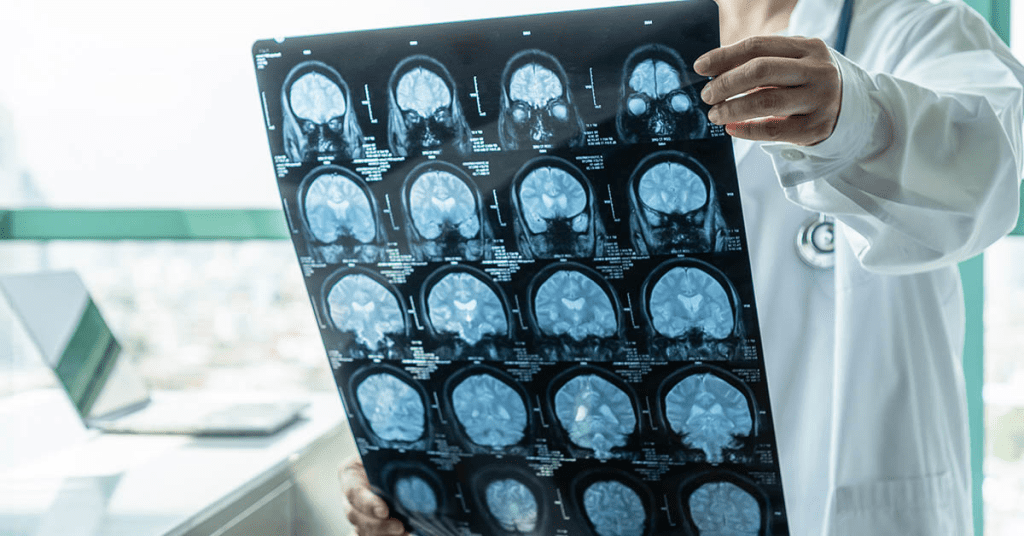In today’s fast-paced world, many of us are focused on physical appearance or career achievements, often forgetting the deeper implications of our lifestyle choices. According to Dr. Kim Johnson Hatchett, a neurologist, the single scariest habit she sees people adopting is the neglect of physical activity—especially strength training—and its alarming impact on brain health. In this article, we’ll explore why neglecting your body may be the most dangerous thing you can do to your brain.
The Connection Between Muscle and Brain Health

We often think of brain health and physical health as two separate entities. But Dr. Hatchett emphasizes a lesser-known fact: our muscles and brain are inextricably linked. When people experience muscle weakness, they might not think of it as a brain issue. However, Dr. Hatchett explains that muscle weakness can significantly reduce the brain’s production of nerve growth factor (NGF), a critical peptide that helps neurons function and regenerate.
This is more than just a theory. Dr. Hatchett has seen countless patients in her practice who report declining muscle strength without realizing that the underlying issue could be deteriorating brain function. Muscle weakness doesn’t just make daily tasks harder—it can accelerate cognitive decline.
Muscle Weakness: The Brain’s Silent Saboteur
Muscle weakness, according to Dr. Hatchett, can be considered a silent saboteur of brain health. Many of her patients, particularly those in their 30s and 40s, fail to see the link between their increasing lack of mobility and their cognitive health. The connection between the two? As muscle movement decreases, so does the stimulation of the brain’s neurons.
Lack of muscle engagement reduces the production of essential peptides like nerve growth factor, which supports neurons and myelin. Myelin is crucial for cognitive function—it’s the protective covering that allows electrical impulses to flow efficiently through the brain. Without proper stimulation through movement, myelin degrades, leading to slower thinking, memory issues, and an increased risk of neurodegenerative diseases.
The Inactivity Epidemic and Its Consequences
Modern lifestyles, with long hours spent sitting in front of computers or binge-watching television shows, only exacerbate this problem. Dr. Hatchett highlights the troubling trend of people in their 30s and 40s neglecting exercise as they prioritize busy work schedules or leisure activities that require minimal movement. The result? A society where physical inactivity is rampant and, consequently, where cognitive decline sets in far earlier than it should.
Dr. Hatchett states, “Even a little bit of daily movement reduces your dementia risk.” Her warning is clear: the modern epidemic of inactivity is not just weakening bodies; it’s also weakening minds. This lack of physical exercise contributes to the development of cognitive diseases like Alzheimer’s and dementia, conditions that are increasingly affecting younger populations.
How Exercise Boosts Brain Function
It’s not all bad news, though. Dr. Hatchett’s research shows that regular exercise—particularly strength training and cardiovascular workouts—has a profoundly positive impact on the brain. Here’s how it works:
Every time you engage in physical activity, your brain receives increased blood flow. This surge of oxygen-rich blood helps improve cognitive function by enhancing the delivery of essential nutrients and removing waste products. Exercise promotes neurogenesis, the process by which new neurons are formed in the brain, especially in areas responsible for memory and learning.

Additionally, physical exercise helps create new neural pathways, essentially “rewiring” the brain. Learning new movements or taking on unfamiliar exercises forces your brain to adapt, strengthening both the body and the mind. Dr. Hatchett likens it to building a bridge: the more you practice new movements, the stronger and more stable the neural connections become.
The Importance of Strength Training for Cognitive Health
Strength training is particularly vital as we age. After the age of 30, muscle mass begins to decline naturally—a process known as sarcopenia. Without regular strength training, this muscle loss accelerates, impacting not only physical mobility but also brain function. By the time people reach their 50s, this muscle loss can become more pronounced, making everyday tasks—like carrying groceries or climbing stairs—significantly more difficult.
Dr. Hatchett stresses that strength training is one of the most effective ways to preserve both mobility and mental clarity. By lifting weights or performing resistance exercises, we’re not just building muscle—we’re also stimulating the brain and preventing the decline in neural connectivity that leads to cognitive disorders. In fact, regular strength training can help delay the onset of dementia and Alzheimer’s disease by keeping both the body and brain active.
Reclaiming Control Over the Aging Process

One of Dr. Hatchett’s most important messages is that the physical and mental decline that we often associate with aging is not inevitable. Through regular physical activity, particularly strength training, we have the power to take control of our health. Just as we save money for retirement to ensure financial security in our later years, exercising today acts as an investment in our future brain health.
Dr. Hatchett encourages everyone to rethink their approach to aging. Rather than accepting that getting weaker and experiencing cognitive decline is part of growing older, we should recognize that exercise can help us maintain strength, mobility, and mental clarity well into our later years. With consistent effort, it’s possible to live an active, vibrant life even in your 60s, 70s, and beyond.
The Simple Steps to Protect Your Brain

It’s never too late to start investing in your brain’s future, and Dr. Hatchett offers simple, practical advice to incorporate more movement into your daily life:
- Incorporate Strength Training: Lifting weights or using resistance bands can be done at home or in a gym. Even small amounts of strength training help preserve muscle mass and improve cognitive health.
- Move More During the Day: You don’t need to spend hours at the gym. Regular movement throughout the day—such as walking, stretching, or taking the stairs—can make a big difference.
- Try Something New: Engage in new physical activities to challenge both your body and brain. Try yoga, Pilates, or even dancing to create new neural pathways and improve coordination.
- Consistency is Key: While any movement is better than none, the key to long-term benefits is consistency. Make physical activity a part of your daily routine for the best results.
Conclusion: Exercise Now to Protect Your Brain’s Future

Dr. Hatchett’s insights offer a sobering reminder that neglecting our physical health directly impacts our brain’s future. The scariest thing she sees isn’t just muscle weakness—it’s the cognitive decline that follows from years of inactivity. However, her message is also one of hope: by incorporating regular strength training and movement into our lives, we can prevent muscle loss, safeguard our brains, and take control of our aging process.
The best time to start investing in your brain’s future is now. The simple act of moving your body today could be the key to preserving your mental clarity for years to come. So, let’s take the first step toward a healthier, stronger, and sharper future.


